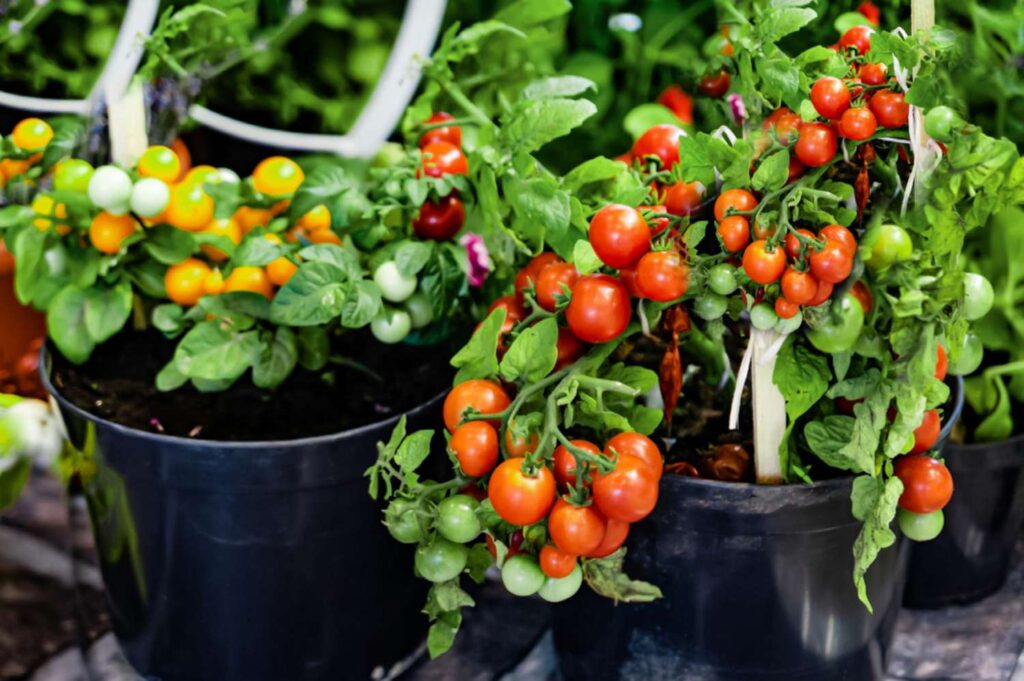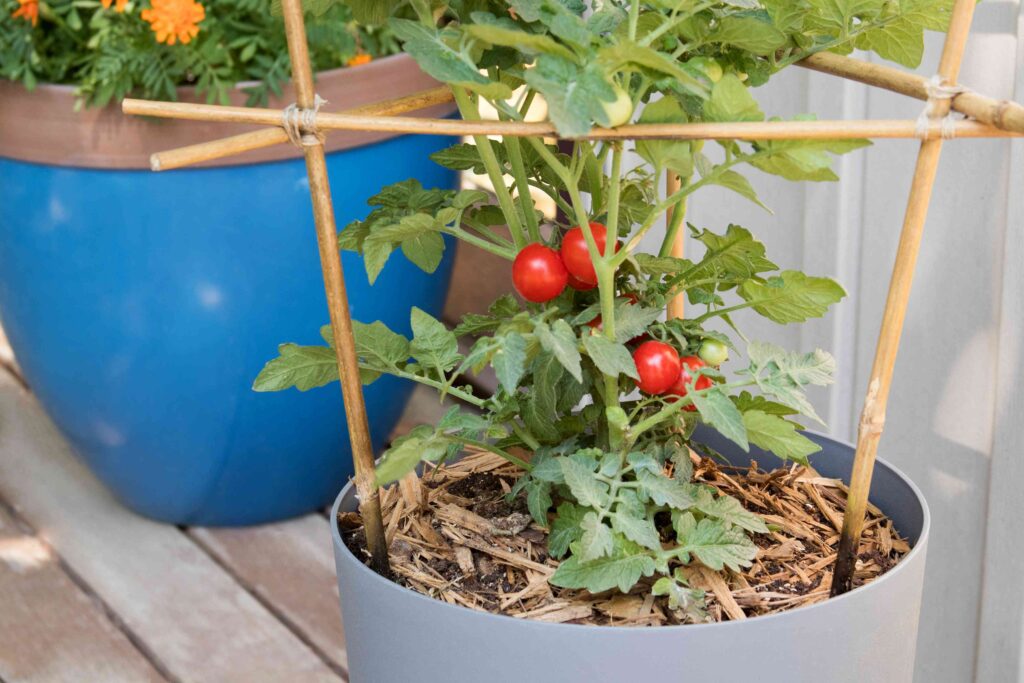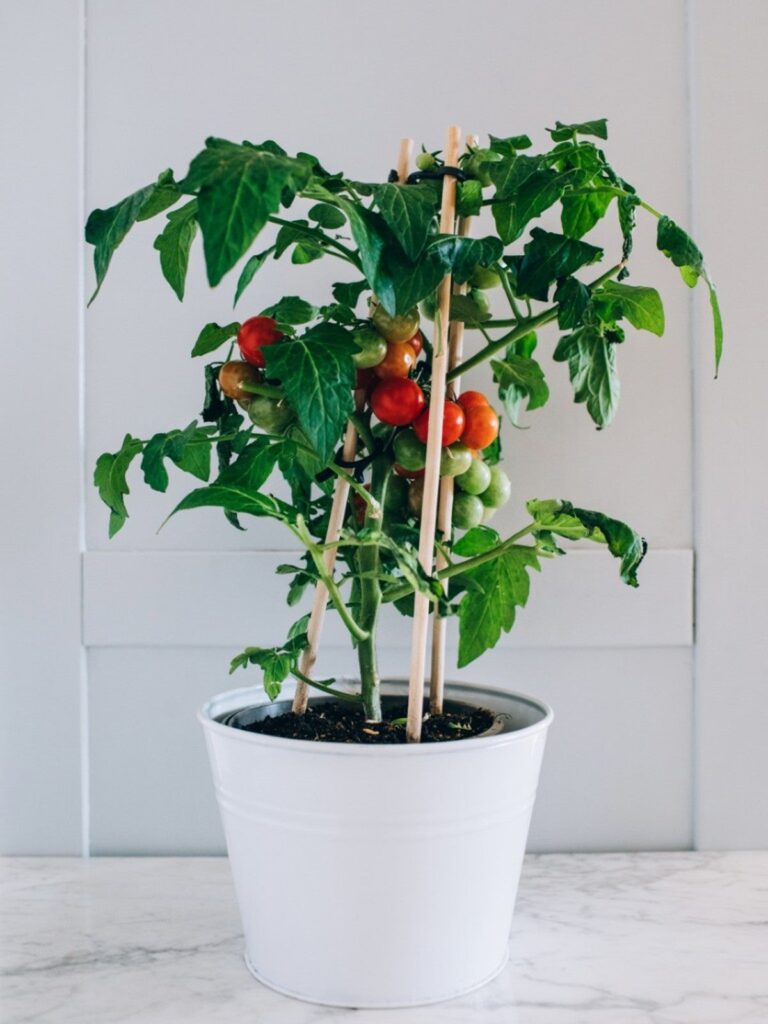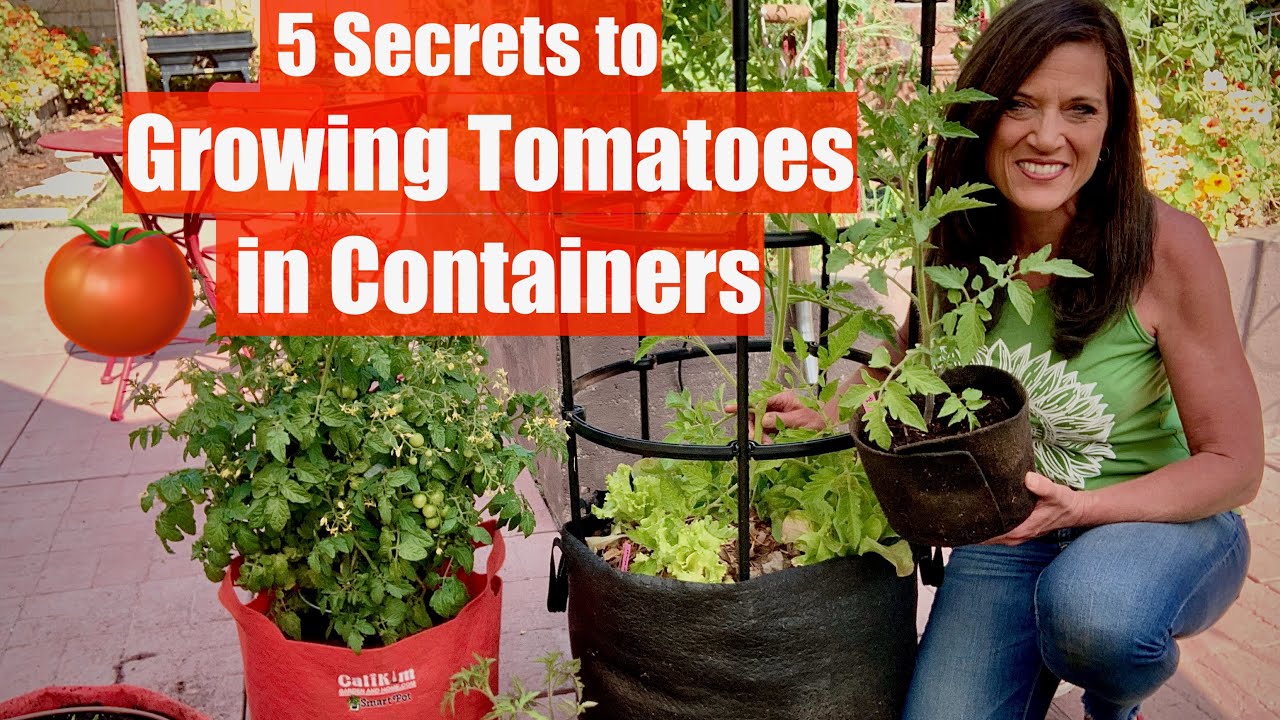In order to maximize the growth and productivity of tomatoes in a container, it is crucial to carefully consider the companions you choose to plant alongside them. By selecting compatible plants, you can create a harmonious and beneficial environment that promotes healthy growth, enhances pollination, and deters pests. This article explores the top choices for companion plants to grow with tomatoes in a container, providing valuable insights and recommendations for a successful gardening experience. From aromatic herbs to vibrant marigolds, discover the ideal partners to create a thriving container garden that will yield bountiful tomato harvests.

Companion Plants for Tomatoes
Tomatoes are one of the most popular vegetables (though technically a fruit) to grow in home gardens. They are not only delicious, but they also provide numerous health benefits. When it comes to cultivating tomatoes, companion planting is an effective technique that can greatly enhance their growth and overall health. Companion plants are those that can be planted alongside tomatoes to provide various benefits such as pest control, increased yield, enhanced flavor, and attracting beneficial insects. In this comprehensive article, we will explore the different types of companion plants that are suitable for tomatoes, taking into consideration factors such as herbs, vegetables, flowers, root vegetables, fruits, plants for pest control, plants to enhance tomato flavor, and plants that attract beneficial insects. Additionally, we will discuss best planting practices, including planting distance and spacing, container size and depth, soil requirements, and watering and fertilizing techniques. So, let’s dive into the world of companion plants for tomatoes and uncover the secrets to a successful and thriving tomato garden.
Benefits of Companion Planting
Companion planting offers numerous benefits for tomato plants. One of the key advantages is pest control. Certain companion plants can help repel or deter pests that are harmful to tomatoes. Additionally, companion plants can attract beneficial insects such as bees and butterflies, which can assist in pollination and lead to a higher yield. Another advantage is the improvement of tomato flavor. Some companion plants release aromatic compounds that can enhance the taste and aroma of tomatoes. Furthermore, companion planting helps maximize space utilization in the garden and can provide shade, support, or trellising for the tomato plants. Finally, companion plants can contribute to overall soil health by providing nutrient cycling and improving soil structure. By understanding and utilizing the benefits of companion planting, you can foster a harmonious and thriving tomato garden.
Factors to Consider When Choosing Companion Plants
When selecting companion plants for tomatoes, it is important to consider several factors. Firstly, choose plants that have similar growth requirements in terms of sunlight, water, and soil conditions. This will ensure that all plants in the container or garden bed can thrive together without competing for resources. Additionally, consider the height and spread of the companion plants. Avoid planting tall or sprawling plants that may overshadow or crowd the tomato plants, resulting in poor growth. It is also essential to think about the compatibility of the plants in terms of root interactions. Some plants, like onions and garlic, release substances that can inhibit the growth of other plants. On the other hand, some companion plants have positive effects on tomatoes, such as repelling pests or attracting beneficial insects. By carefully considering these factors, you can create a harmonious and beneficial environment for your tomatoes.
Plants to Avoid Planting with Tomatoes
While there are numerous companion plants that can benefit tomatoes, there are also some plants that should be avoided when planting alongside tomatoes. These plants can have adverse effects on tomato growth and can impede their development. Some plants that are incompatible with tomatoes include members of the Brassica family, such as cabbage, broccoli, and cauliflower. These plants compete with tomatoes for nutrients and can stunt their growth. Additionally, corn and potatoes are not suitable companions for tomatoes as they can attract pests that are detrimental to tomato plants. By avoiding these incompatible plants, you can safeguard the health and growth of your tomatoes.
Complementary Companion Plants for Tomatoes
Now, let’s delve into the world of complementary companion plants for tomatoes. These are the plants that can be beneficial and thrive alongside tomatoes, providing various advantages. We can categorize these companion plants into different groups, including herbs, vegetables, flowers, root vegetables, fruits, plants for pest control, plants to enhance tomato flavor, and plants that attract beneficial insects. Let’s explore each category in detail.
Herbs
Basil: Basil is a versatile herb that not only adds a delightful flavor to your tomato dishes but is also an excellent companion plant for tomatoes. It helps repel aphids, mosquitoes, flies, and other pests that can damage tomatoes. The aroma of basil can also enhance the flavor of tomatoes.
Dill: Dill is another herb that pairs well with tomatoes. It attracts hoverflies, which are predators of aphids, providing natural pest control for your tomatoes. Moreover, dill can improve the growth and flavor of tomatoes when planted together.
Parsley: Parsley is not only a popular culinary herb, but it also acts as a beneficial companion plant for tomatoes. It attracts hoverflies and predatory wasps, which prey on tomato pests such as aphids and caterpillars. Additionally, parsley can help improve the flavor of tomatoes.
Oregano: Oregano is known for its strong flavor and aroma, which can complement the taste of tomatoes. It also repels pests such as aphids, spider mites, and whiteflies, making it a valuable companion for tomatoes.

Vegetables
Lettuce: Lettuce is an ideal companion plant for tomatoes due to its shallow root system. It can provide shade to the soil around the tomato plants, helping to retain moisture and regulate soil temperature. Additionally, lettuce can deter pests that are harmful to tomatoes, such as slugs.
Peppers: Peppers and tomatoes are part of the same family, making them compatible companion plants. They have similar growth requirements and can benefit from each other’s presence. Planting peppers alongside tomatoes can help deter pests and increase pollination, resulting in a higher yield for both crops.
Spinach: Spinach can be grown alongside tomatoes as a beneficial companion plant. Its dense foliage provides shade to the soil, reducing weed growth and conserving moisture. Spinach also helps protect tomato plants from intense sunlight.
Cucumbers: Cucumbers are excellent companion plants for tomatoes as they can act as natural trellises. By planting cucumbers next to tomatoes, you can utilize vertical space and provide support for the sprawling tomato vines. Moreover, cucumbers and tomatoes can maximize pollination when grown together.
Flowers
Marigolds: Marigolds are widely recognized as one of the best companion plants for tomatoes. They repel nematodes, tomato hornworms, and whiteflies due to their strong fragrance. Planting marigolds around tomatoes can help protect them from these common pests.
Nasturtiums: Nasturtiums are another flower that can provide numerous benefits to tomato plants. They act as a trap crop, attracting aphids away from tomatoes. Nasturtiums also repel whiteflies and can enhance the overall growth and flavor of tomatoes.
Calendula: Calendula, also known as pot marigold, has similar pest-repelling properties as marigolds. It can repel aphids, tomato hornworms, and whiteflies. Additionally, the vibrant flowers of calendula can add beauty to your tomato garden.
Petunias: Petunias are not only visually appealing but also offer advantages as companion plants for tomatoes. They repel aphids and other common pests. Planting petunias in containers or garden beds alongside tomatoes can create an aesthetically pleasing and functional display.
Root Vegetables
Carrots: Carrots can be successfully grown alongside tomatoes as complementary companion plants. Since tomatoes have deep roots while carrots have shallower roots, they can utilize the soil space more efficiently. Furthermore, the scent of carrots can help repel pests that are harmful to tomatoes.
Radishes: Radishes are beneficial companion plants for tomatoes due to their fast-growing nature. They can be intercropped with tomatoes, allowing you to make the most of limited space. Radishes also help prevent soil compaction around tomato roots.
Onions: Onions and tomatoes are mutually beneficial companions. Onions can help repel pests such as aphids, spider mites, and thrips. Conversely, the strong scent of tomatoes can help deter onion flies. Planting onions alongside tomatoes can create a natural pest control barrier.
Garlic: Garlic is well-known for its pest-repelling properties. It can deter aphids, spider mites, and other pests that can damage tomato plants. Garlic also improves soil health and can help prevent diseases in tomato plants.
Fruits
Strawberries: Strawberries can be a beautiful and practical addition to your tomato garden. They are compatible companion plants and can provide ground cover, suppressing weeds and conserving moisture. Additionally, strawberries enhance the flavor of tomatoes when planted together.
Blueberries: Blueberries are nitrogen-loving plants, and tomatoes release excess nitrogen into the soil. As a result, the presence of blueberries can help reduce nitrogen levels in the soil, creating a more balanced growing environment for tomatoes. Both plants can thrive when planted in close proximity.
Raspberries: Raspberries are another fruit that can be grown alongside tomatoes. They have similar growth requirements and can provide shade to tomato plants, reducing water evaporation and maintaining soil moisture. The combination of raspberries and tomatoes can create a visually appealing and productive garden bed.
Cantaloupe: Cantaloupe and tomatoes are compatible companion plants that can be grown together successfully. Cantaloupe vines can act as natural trellises for tomato plants, saving space and providing support. The combination of these two plants can result in a bountiful harvest of juicy tomatoes and sweet cantaloupes.

Companion Plants for Pest Control
Marigolds: Marigolds are not only advantageous for pest control but also serve as attractive flowers in the garden. They repel various pests such as nematodes, tomato hornworms, whiteflies, and aphids. The strong aroma of marigolds acts as a natural deterrent.
Basil: Basil is a versatile herb that not only enhances the flavor of tomatoes but also repels pests. It can deter aphids, flies, and mosquitoes, which can be harmful to tomato plants. Planting basil near tomatoes can act as a natural pest control measure.
Nasturtiums: Nasturtiums are particularly effective in pest control as they act as trap crops for aphids. By attracting aphids away from tomatoes, nasturtiums help protect tomato plants. They also repel whiteflies and serve as an ornamental addition to the garden.
Garlic: Garlic is well-known for its insect-repellent qualities. It deters aphids, spider mites, and other pests that can damage tomato plants. Planting garlic around tomatoes can create a protective barrier against common pests.
Plants to Enhance Tomato Flavor
Basil: Basil is not only a popular herb in tomato-based dishes but also enhances the flavor of tomatoes when planted together. The aromatic compounds of basil can create a more robust and delicious tomato flavor.
Oregano: Oregano offers a strong and distinct flavor that pairs well with tomatoes. When grown in close proximity, the flavors of oregano and tomatoes can harmonize, resulting in a delightful taste experience.
Parsley: Parsley is often used as a garnish, but it also contributes to the flavor profile of tomatoes. The combination of parsley and tomatoes can add complexity to dishes and elevate the overall taste.
Rosemary: Rosemary is a fragrant herb that can enhance the flavor of tomatoes. Its earthy and pine-like aroma complements the sweetness of tomatoes, creating a delightful combination in various culinary creations.

Plants that Attract Beneficial Insects
Borage: Borage is an excellent companion plant for tomatoes as it attracts beneficial insects such as bees and predatory wasps. Bees are crucial for tomato pollination, while predatory wasps can help control pests, resulting in healthier tomato plants.
Dill: Dill is not only a flavorful herb but also acts as a magnet for beneficial insects. It attracts hoverflies, which are natural predators of aphids. By attracting hoverflies, dill can contribute to natural pest control in your tomato garden.
Cilantro: Cilantro, also known as coriander, is a versatile herb that can attract beneficial insects to your tomato garden. It provides habitat and food sources for predatory insects, such as ladybugs and lacewings, which help control pests.
Fennel: Fennel is an herb that attracts a wide range of beneficial insects, including parasitic wasps and syrphid flies. These insects prey on pests that can damage tomato plants, making fennel an excellent companion plant for tomatoes.
Best Planting Practices
To ensure the success and health of your tomatoes and their companion plants, it is crucial to follow best planting practices. Consider the following factors when planning and planting your tomato garden:
Planting Distance and Spacing: Allow adequate spacing between tomato plants and their companion plants to prevent overcrowding. The specific spacing requirements may vary depending on the plants you choose, so refer to their individual care instructions for guidance.
Container Size and Depth: Ensure that the container you choose for planting tomatoes and their companions is large enough to accommodate the root systems of all the plants. The depth of the container should be sufficient to promote healthy root growth.
Soil Requirements: Prepare the soil by incorporating organic matter such as compost to improve its nutrient content and drainage. Test the soil pH to ensure it falls within the appropriate range for tomatoes and their companion plants.
Watering and Fertilizing: Provide adequate and consistent water to your tomato plants and their companions, taking care not to overwater or underwater. Monitor the moisture levels in the soil and adjust watering accordingly. Additionally, fertilize regularly using organic fertilizers to ensure optimal nutrient availability.
By following these best planting practices and considering the specific needs of your tomato plants and their chosen companions, you can create an environment that promotes growth, productivity, and harmony among the plants.
In conclusion, companion planting is an invaluable technique that can greatly enhance the growth, health, and productivity of tomato plants. By selecting suitable companion plants and considering factors such as herbs, vegetables, flowers, root vegetables, fruits, plants for pest control, plants to enhance tomato flavor, and plants that attract beneficial insects, you can create a diverse and thriving tomato garden. Implementing best planting practices such as proper spacing, suitable containers, appropriate soil preparation, and optimal watering and fertilizing techniques will further contribute to the success of your tomato garden. So, unleash your creativity and experiment with different combinations of companion plants for tomatoes to discover the wonders of companion planting and enjoy a bountiful harvest of delicious tomatoes.



